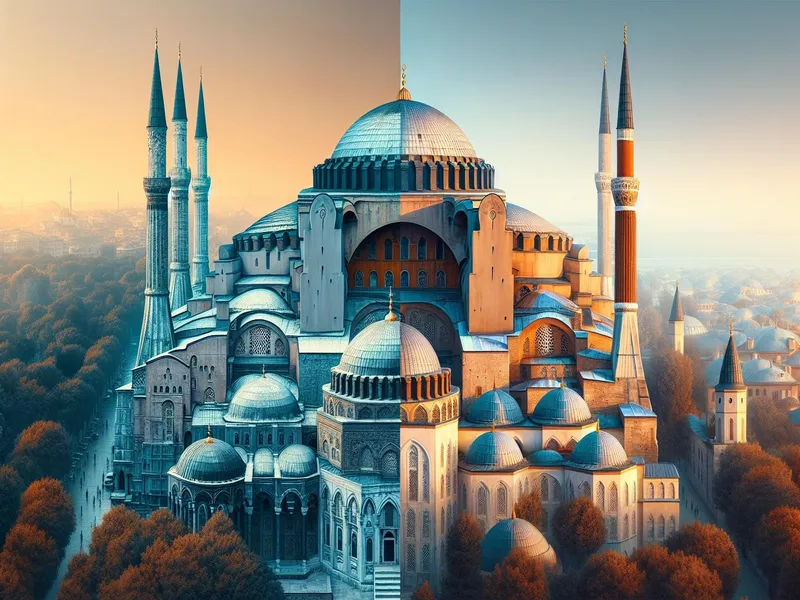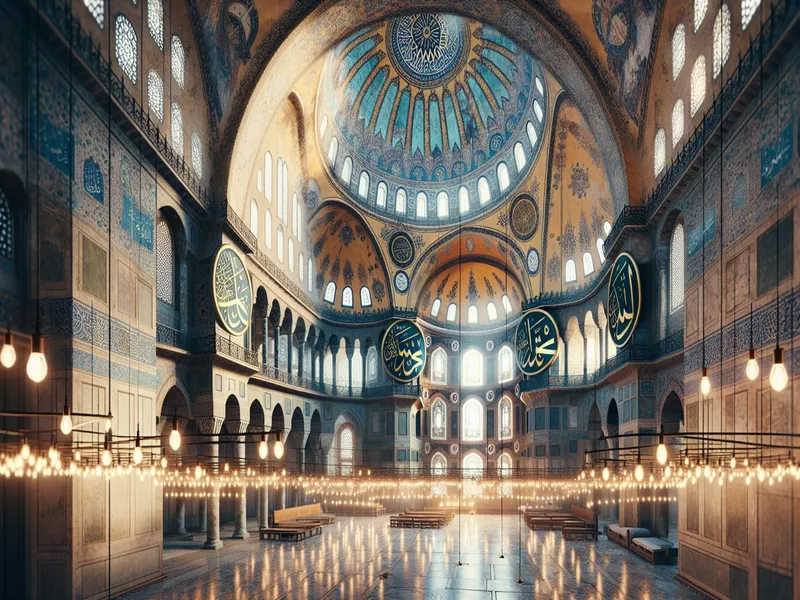the rich history of Istanbul with a visit to Hagia Sophia and the Blue Mosque. Explore their unique architecture and get practical backpacking tips for an unforgettable trip.

Historical Background
When you visit Istanbul, it’s impossible not to be captivated by the stories behind its two most famous landmarks: Hagia Sophia and the Blue Mosque. Each has a rich history that adds layers to your journey through time.
Hagia Sophia
Built in 537 AD, Hagia Sophia started as an Eastern Orthodox cathedral under Emperor Justinian I. For nearly 1,000 years, it was the world’s largest cathedral until Seville Cathedral took over in 1520. In 1453, after Constantinople fell to the Ottoman Empire, Sultan Mehmed II converted it into a mosque—a status it kept for almost five centuries.
Interesting tidbit: During its transformation from a church to a mosque, many Christian mosaics were plastered over but weren’t destroyed. You can still see some of them today—talk about hidden gems! The building became a museum in 1935 thanks to Mustafa Kemal Atatürk’s secular vision for Turkey. Recently though, in 2020, it reverted back to being a mosque.
Historical timelines aside, when you’re inside Hagia Sophia soaking up its splendor (seriously stunning), you can feel the blend of Byzantine and Ottoman architecture. It’s like stepping into different worlds at once!
Blue Mosque
The Blue Mosque, or Sultan Ahmed Mosque as it’s officially known, was completed in 1616 during Sultan Ahmed I’s reign. Designed by Sedefkar Mehmed Agha—a student of Sinan (the Michelangelo of Ottoman architecture)—it stands as one of Istanbul’s most beautiful structures.
You can’t miss this place; it’s got six minarets which was quite controversial back then because Mecca’s Grand Mosque had only six too! Don’t worry though—they added another minaret to Mecca later on . What makes it blue, you ask? Well inside there are over 20,000 handmade ceramic tiles with blue hues that give off an ethereal glow when sunlight streams through hundreds of windows.
Here’s something cool: If you’re into backpacking like me ️ and love people-watching while absorbing local culture—head here during prayer times (non-Muslims aren’t allowed inside then). Just sitting outside listening to the call-to-prayer surrounded by locals is magical!
| Feature | Hagia Sophia | Blue Mosque |
|---|---|---|
| Built | 537 AD | Completed in 1616 |
| Original Use | Eastern Orthodox Cathedral | Ottoman Imperial Mosque |
| Key Architectures | Byzantine & Ottoman | Classical Ottoman |
| Notable Fact | World’s largest cathedral for ~1K years | Six minarets caused controversy |
Architectural Style

When we’re in Istanbul, the architectural wonders of Hagia Sophia and the Blue Mosque are a must-see. Let’s jump into their unique styles!
Hagia Sophia
Hagia Sophia’s architecture is like stepping back in time. Built in 537 AD, it started as an Eastern Orthodox cathedral. You can still see Byzantine elements mixed with Ottoman touches from its mosque days.
- Byzantine Influence: The massive dome seems to float above you, supported by pendentives (those triangular sections). This was groundbreaking back then!
- Ottoman Additions: Look for minarets added later on. They blend well with the original structure.
- Hidden Gems: Christian mosaics peek out from beneath layers of plaster—a real historical treasure hunt!
I remember my first visit; I felt like Indiana Jones uncovering ancient secrets!
Blue Mosque
The Blue Mosque, or Sultan Ahmed Mosque, completed in 1616, is equally stunning but different. It’s famous for its six minarets and blue tiles inside.
- Ottoman Grandeur: Those six minarets caused quite a stir because they matched Mecca’s Grand Mosque. Imagine the drama!
- Interior Beauty: Over 20,000 handmade blue ceramic tiles line the walls—hence the name “Blue Mosque.” During my visit at dusk prayer time, the ambiance was magical.
- Functional Design: Unlike Hagia Sophia’s mix of styles due to conversions, this mosque retains its original design intent as a place of worship.
When backpacking through Istanbul, these landmarks offer contrasting yet complementary experiences that showcase centuries of history and art under one city sky.
Interior Design and Artwork

When exploring Istanbul, you can’t miss the breathtaking interiors of Hagia Sophia and the Blue Mosque. They’re like stepping into a different world.
Hagia Sophia
Walking into Hagia Sophia feels like entering a time capsule. This place is massive! The sheer size of its dome is awe-inspiring, almost 100 feet across. Imagine standing there with shafts of light streaming down from the dome’s windows .
You’ll see stunning mosaics that date back to the Byzantine era. Look closely, and you’ll find hidden Christian artworks beneath layers of plaster—remnants from when it was a cathedral. It’s fascinating how these ancient mosaics coexist with Islamic calligraphy on massive medallions hanging around the interior.
I remember my first visit; I was struck by how the space felt both grand and intimate at the same time. You can just stand there for hours, absorbing all the details—the marbles, columns, and arches blending seamlessly in this architectural masterpiece.
- Dome Size: ~100 feet
- Artwork: Mosaics & Calligraphy
- Era: Byzantine & Ottoman
Blue Mosque
On to the Blue Mosque—this one’s equally enchanting but in a totally different vibe. As soon as you step in, you’re surrounded by over 20,000 handmade blue tiles that give it its name.
The patterns on these tiles are mesmerizing—think intricate floral designs mixed with geometric shapes that seem to dance as you walk through. The mosque’s chandeliers hang low, giving off a soft glow that enhances its serene atmosphere.
One thing I love about visiting during prayer times is seeing locals gather for worship—it adds an authentic touch to your experience. Plus, there’s nothing quite like hearing the call to prayer echo through those beautiful domes; it’s magical ✨.
I’ve found myself returning here often just to sit quietly and soak up the peaceful ambiance—you can too!
- Tiles: 20,000+ Handmade Ceramic Tiles
- Design Elements: Floral & Geometric Patterns
- Atmosphere: Serene & Peaceful
Here’s a quick comparison table for easy reference:
| Feature | Hagia Sophia | Blue Mosque |
|---|---|---|
| Dome Size | ~100 feet | Multiple smaller domes |
| Primary Artwork | Mosaics & Calligraphy | Handmade Ceramic Tiles |
| Atmosphere | Grand yet Intimate | Serene & Peaceful |
Cultural and Religious Significance
Hagia Sophia and the Blue Mosque are more than just stunning landmarks. They embody rich cultural histories, religious significance, and serve as symbols of Istanbul’s diverse heritage.
Hagia Sophia
Stepping into Hagia Sophia feels like entering a time capsule. This architectural marvel witnessed centuries of change and adaptation. Initially an Eastern Orthodox cathedral, it later became a mosque after the fall of Constantinople in 1453. The transformation didn’t stop there—it was turned into a museum in 1935 before reverting to a mosque in 2020.
- Blend of Cultures: You can see Christian mosaics alongside Islamic calligraphy.
- Architectural Feats: Byzantine dome supported by pendentives (triangular segments that transition from square to circular base).
- Multi-layered History: Hidden Christian mosaics beneath layers of plaster.
During my visit, I felt both awe-struck and reflective, imagining how different cultures worshipped here over the centuries. It’s like standing at the crossroads of history.
Blue Mosque
The Blue Mosque, or Sultan Ahmed Mosque, is equally captivating but with its own unique charm. Completed in 1616 during Sultan Ahmed I’s reign, it’s renowned for its six minarets—a point of controversy since it matched Mecca’s Grand Mosque minarets.
- Serene Ambiance: Over 20,000 handmade blue ceramic tiles create a tranquil atmosphere.
- Intricate Patterns: Floral and geometric designs showcase Ottoman artistry.
- Cultural Experience: Visiting during prayer times offers a magical experience with the echoing call to prayer.
When I first entered the Blue Mosque, its serene beauty struck me instantly. The peaceful ambiance during prayers transported me to another area entirely—one where you truly appreciate Istanbul’s spiritual depth.
| Feature | Hagia Sophia | Blue Mosque |
|---|---|---|
| Primary Artwork | Christian mosaics & Islamic calligraphy | Handmade blue ceramic tiles |
| Dome Size | Massive central dome | Multiple smaller domes |
| Atmosphere | Grand yet intimate | Serene & enchanting |
Visitor Experience
Ever wondered what it’s like exploring two of Istanbul’s most iconic landmarks? Let me share my experience visiting Hagia Sophia and the Blue Mosque.
Hagia Sophia: A Journey Through Time
Walking into Hagia Sophia feels like stepping through a portal to the past. The first thing that hits you is the sheer size of its dome, which seems to float above you. It’s not just a building; it’s a world of history woven from Byzantine mosaics and Ottoman calligraphy.
- Pro tip: Visit early in the morning or late afternoon to avoid crowds.
- Budget tip: Admission is free since it reverted back to a mosque in 2020.
I loved seeing the hidden Christian mosaics peeking through layers of plaster—like secret messages from another era. The juxtaposition of these mosaics with Islamic art creates an atmosphere that’s both grand and intimate.
Blue Mosque: Serenity in Shades of Blue
Just a short walk away, you’ll find yourself at the Blue Mosque (Sultan Ahmed Mosque), where over 20,000 handmade blue tiles adorn its interior. The ambiance here is serene, almost meditative.
- Fun fact: The mosque has six minarets, which was controversial because it matched Mecca’s Grand Mosque.
- Visiting hours: Non-Muslims can visit outside prayer times, so plan accordingly.
I remember sitting on one of the carpets during prayer time, listening to the call to prayer echoing through the domes—it was pure magic! If you’re into photography , don’t miss capturing those intricate floral and geometric patterns on the tiles.
Quick Comparison Table
| Feature | Hagia Sophia | Blue Mosque |
|---|---|---|
| Built | 537 AD | 1616 AD |
| Architectural Style | Byzantine & Ottoman | Classical Ottoman |
| Dome Diameter | 31 meters | Smaller than Hagia Sophia |
| Main Artwork | Mosaics & Calligraphy | Handcrafted Ceramic Tiles |
| Atmosphere | Grand & Intimate | Serene & Meditative |
Packing Tips for Backpackers
When visiting these sites:
- Wear comfortable shoes ; there’s lots of walking.
- Bring a scarf if you’re female for head covering inside mosques.
- Carry a water bottle ; hydration is key!
Exploring these sites made me appreciate how diverse and rich Istanbul’s heritage is. Whether you’re marveling at Hagia Sophia’s grandeur or finding peace in Blue Mosque’s serenity, both landmarks offer unique glimpses into this amazing city’s soul.
Exploring Hagia Sophia and the Blue Mosque isn’t just about admiring their architectural brilliance; it’s about immersing yourself in Istanbul’s rich world of history and culture. Each visit offers a unique peek into different eras that have shaped this vibrant city.
Hagia Sophia’s blend of Byzantine and Ottoman influences, along with its monumental dome and hidden mosaics, creates an awe-inspiring experience. On the other hand, the Blue Mosque enchants with its serene atmosphere, stunning blue tiles, and the harmonious call to prayer.
Both landmarks offer distinct yet complementary experiences that deepen my appreciation for Istanbul’s diverse heritage. Whether you’re drawn to the historical grandeur of Hagia Sophia or the tranquil beauty of the Blue Mosque you’ll find both sites captivating in their own right.